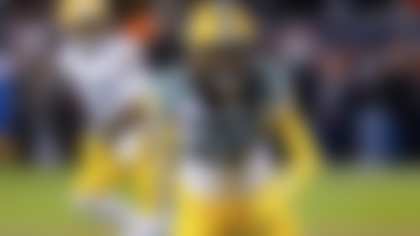Deshone Kizer. Leonard Fournette. Dalvin Cook. Christian McCaffrey. Mike Williams.
These are just a few of the names on a long list of rookies who will be thrown at fantasy football enthusiasts over the next several weeks. You're going to hear all kinds of analysis about these players too. This dude runs fast. That dude is strong. This dude is smart. That one, maybe not so much. Lots of fantasy folks are even doing their best Mike Mayock, Daniel Jeremiah or Bucky Brooks impressions and "watching tape" in an effort to offer opinions on how players will produce in the NFL.
While that's all well and good, I like to go outside the box and look at trends.
One trend in particular that some people brush off as coincidence is the success or failure rate of players at certain offensive positions drafted out of same colleges. Now I get it ... a quarterback who came out of California 10 seasons ago, for example, had different players around him, different coaches in his ear and a different system than one that came out in 2016. So, does it actually matter where he attended school? And how could that become a predictive tool for his NFL career?
Maybe it doesn't matter. But maybe, in cases where there is a decent sample size that unveils a trend, analysts should take note. If nothing else, this is fun fodder for fans to discuss ahead of April's draft ... and it isn't the same old discussion about how a kid did at the Combine or what he looks like on tape. Remember what scouts said about Tom Brady? "Poor build, skinny, lacks great physical stature and strength." Hell, Giovanni Carmazzi was picked ahead of Brady in the 2000 NFL Draft. Brady has gone on to become the greatest NFL quarterback ever.
As for Carmazzi, he's now a goat farmer.
So for your information pleasure, I looked at the positions and schools (dating back to 1990) that pertain to the players projected to make the biggest fantasy impact from the 2017 class to see if I could find any trends (and I did). Now you'll know what I'm talking about, in part, when I promote Alvin Kamara or D'Onta Foreman as sleepers. However, let's start off with one of the biggest examples of how a position and school combination can sometimes predict a player's NFL fate.
I'm looking at you, Southern California...
USC wide receivers
A total of 22 Trojan wideouts have been drafted since 1990. The best of the bunch at the pro level include Keyshawn Johnson (1998), Curtis Conway (1993) and Johnnie Morton (1994). Now let's look at some of the more recent wideouts to leave the school for the pros. Since 2000, 10 USC receivers have been picked in the first three rounds of the NFL Draft. That list includes R. Jay Soward (2000), Keary Colbert (2004), Mike Williams (2005), Dwayne Jarrett (2007), Steve Smith (2007), Patrick Turner (2009), Damian Williams (2010), Robert Woods (2013), Marqise Lee (2014) and Nelson Agholor (2015).
Smith is the lone wideout to record a 1,000-yard season from this post-2000 group, and he did it once. Soward and Mike Williams, both drafted in the first round, combined to record 1,680 yards and six touchdowns in their careers. Woods has averaged 51 catches for 613 yards and three touchdowns per year in 48 games with Buffalo, while Agholor has recorded 59 catches and three touchdowns in two pro seasons. Maybe the Philadelphia Eagles wouldn't haven blown a first-round selection on the latter had this trend been on their radar.
This is enough data and a big enough sample size for me to have doubts about JuJu Smith-Schuster's fantasy value at the pro level, much like I had with Woods, Lee and Agholor in recent seasons. USC fans, let the Twitter rage begin.
Notre Dame quarterbacks
If you think Southern California wideouts have a bad trend, I present to you the (drafted) offensive skill position players of Notre Dame ... in this case, quarterbacks. Now, don't give me the oldies but goodies like Daryle Lamonica, Joe Theismann, or Joe Montana. I'd like to stick with dudes who've played since 1990. Let's start off with Ron Powlus, who for all his potential at the collegiate level, fell short on the field and wasn't even selected in the NFL Draft. Rick Mirer (1993) and Brady Quinn (2007) were first-round failures, and Jimmy Clausen (2010) did zilch as a second-round selection.
Notre Dame hasn't had any real NFL prospects at signal-caller in the last half decade, at least not until Deshone Kizer took over the reins of the offense. Mayock's top-rated quarterback prospect, Kizer doesn't figure to suffer the same fate as Powlus, Mirer, Quinn or Clausen, at least from a fantasy perspective. Why? Well, he has something those players didn't ... he's a dual threat. Over Kizer's 25 games at the college level, he rushed for 997 yards (40 YPG) and 18 touchdowns. If running quarterbacks from other schools like Tim Tebow and Terrelle Pryor can impact fantasy football, so can Kizer.
Florida State running backs
Dalvin Cook, who had a poor performance at the NFL Scouting Combine, rushed for 1,000-plus yards in each of his three seasons with the Seminoles. He is also a skilled receiver, and he led the nation with 90 forced missed tackles in 2016. Florida State hasn't been a hotbed for fantasy runners since 1990, however. In fact, Warrick Dunn (1997) scored 1,088.2 more points than the second-best FSU back (Edgar Bennett, 1992) in that time. Marion Butts (1990), Amp Lee (1992) and Devonta Freeman (2014) round out the top five fantasy backs drafted out of Florida State during our time frame, with Freeman being the lone member of the trio to make a positive impact.
Despite the lack of production overall, we should keep in mind that seven of the 15 runners drafted out of FSU since 1990 were picked in the fourth round or later. Furthermore, the Seminoles have had just one back (Greg Jones, 2004) picked in the first or second round since 2000. That's not a huge sample size. Overall, I'd still bet on Cook making an impact. In fact, he could end up being the first rookie picked in seasonal and dynasty leagues if he lands with the right team.
LSU running backs
In the last 27 NFL drafts, a combined 15 Tiger running backs have been selected with just six being picked in one of the first two rounds. The most successful back of the bunch came in 2006, as Joseph Addai became a No. 1 fantasy runner for a few seasons with the Indianapolis Colts. LSU has had five backs taken since 2011 with various levels of success, including Stevan Ridley (2011), Spencer Ware (2013), Jeremy Hill (2014) and Alfred Blue (2014). Fournette, projected as a first-rounder, dealt with injuries for much of last season but was an absolute beast in 2015. An old-school runner who has drawn comparisons to Adrian Peterson, Fournette figures to be one of the first two or three rookies picked in most seasonal and dynasty drafts. The Carolina Panthers would be a nice fit.
Oklahoma running backs
When we think about Sooner runners, we think Adrian Peterson, DeMarco Murray and a school that has been chock full of studs at the position. That's not true in our case, at least as it pertains to pro success since 1990. In that time, Oklahoma has had one first-rounder (Peterson, 2007), a second-rounder (Jermaine Fazande, 1999) and two third-rounders (Jerald Moore - 1996, Murray - 2011). Fazande and Moore combined for 1,438 rushing yards in the pros. Furthermore, the remaining eight Sooner rushers (fullbacks included) picked in the last 27 drafts have come off the board in the fourth round or later.
The Sooners have two potential fantasy impact makers in the 2017 class, however, as Joe Mixon and Samaje Perine will draw lots of attention from runner-needy teams. Mixon is an all-around back with great tools as a runner and receiver, but his off-the-field baggage could push him down some draft boards. He's a potential fantasy star if he can keep his head on straight, though. Perine is one-dimensional, but he put up 1,000-plus rushing yards in each of his three seasons at Oklahoma. He also averaged a ridiculous 6.0 yards per attempt. The powerful Perine, who outbenched every runner and almost every offensive lineman at the combine, could be a fit for the Oakland Raiders.
Stanford running backs
To put it kindly, runners drafted out of Stanford since 1990 have not had a whole lot of fantasy success. The best of the bunch is Tommy Vardell, who was the ninth overall selection of the Cleveland Browns in the 1992 draft. However, Vardell never rushed for more than 644 yards in a single season and his 21 total touchdowns were unimpressive when you consider he played for eight years. The highest pick to come out of the school since 2010 is Toby Gerhart, who went to the Minnesota Vikings in the second round. Of course, we all know that he failed to live up to the statistical success he found as an amateur.
Christian McCaffrey, who was considered one of the big winners at the Combine, is a whole lot different than Vardell or Gerhart. He's not a bruiser, which was evident in his bench press numbers, but McCaffrey has proved to be an athletic dynamo who is as good (or better) a receiver as he is a runner. As NFL Network analyst Charlie Casserly tweeted, McCaffrey worked out as a wide receiver and "looked like a first-round pick at the position too." With a small sample size of Stanford backs and a skill set that's conducive to statistical success, I like McCaffrey to buck the "trend" of Cardinal runners. He could become a PPR machine at the next level.
Tennessee running backs
The Volunteers have had more than their share of successful NFL running backs. In fact, the school has produced nine drafted in the first three rounds since 1990. The best of the bunch was Jamal Lewis (2000), who totaled 10,607 career rushing yards and 62 total touchdowns. Tennessee has also put out solid fantasy backs like Travis Henry (2001), James Stewart (1995) and Charlie Garner (1994), all of whom were drafted in the first two rounds. Arian Foster wasn't drafted out of college, but he deserves an honorable mention for his immense fantasy contributions at the next level.
While the last four runners drafted out of the school (Montario Hardesty, Cedric Houston, Troy Fleming, Travis Stephens) didn't have a lot of statistical success, there's still enough of a sample size here to like Alvin Kamara as a potential sleeper. He opened eyes at the Combine too, as Bucky Brooks tweeted Kamara "will walk out of Indy as the biggest winner in RB class." Where he lands will have a huge effect on his ultimate draft value, but Kamara is one to watch.
Texas running backs
Texas has several successful NFL running backs on its resume, with Hall of Famer Earl Campbell leading the group. However, the school has seen just five runners picked in the NFL draft since 1990 and none have been picked since 2009. Two of those runners, Jamaal Charles (2008) and Ricky Williams (1999) were fantasy superstars at the next level. Cedric Benson (2005) never reached that status, though he did have a trio of good fantasy campaigns. The Longhorns also boast Priest Holmes, who was a statistical machine from 2001-2004 but was not selected in the 1997 NFL Draft.
Can D'onta Foreman join Charles and Williams as the next great Texas running back drafted into the NFL? Well, he was forced out of the combine after NFL doctors found a small stress fracture in his foot during medical testing. He didn't know about the fracture, however, so it doesn't appear to be serious. Foreman was a beast in his final collegiate campaign, rushing for 2,028 yards with 15 touchdowns. If the right team drafts him, say the Raiders, Colts, Panthers or Jets, he could wind up being a potential sleeper in 2017 fantasy drafts. Keep tabs on where he lands.
Clemson wide receivers
When you think about Clemson football, you think about wide receivers right? If not, maybe you should. Since 2013, four Tiger wideouts have been drafted. Of that quartet, two (Sammy Watkins, DeAndre Hopkins) came in the last three drafts and were selected in the first round. Watkins and Hopkins have combined to score 40 touchdowns at the pro level, a total that would be much higher had the former not missed so much time due to injuries. Then there's Martavis Bryant, who possesses all the talent in the world but has seen his rise to fantasy stardom slowed due to off-the-field issues. If the recent success of wideouts from Clemson (albeit a small smaple size) is an indicator, Mike Williams has a shot to be an impact maker right out of the gate. Based on his physical and athletic skills, there's a whole lot to like.
Miami (FL) tight ends
The Hurricanes might be better known for producing top-notch running backs, but take a look at some of the tight ends that have come out of the school. Bubba Franks (2000), Jeremy Shockey (2002), Kellen Winslow (2004), Greg Olsen (2007) and Jimmy Graham (2010) have all been home runs for fantasy owners, and some believe Clive Walford (2015) has sleeper appeal. Enter David Njoku, an athletic freak who'll be a matchup nightmare at the pro level. Rookies typically don't make a big fantasy impact at the position (Hunter Henry was an outlier), but Njoku has serious intermediate- and long-term fantasy appeal.
Michael Fabiano is an award-winning fantasy football analyst on NFL.com and NFL Network and a member of the Fantasy Sports Writers Association (FSWA) Hall of Fame. Have a burning question on anything fantasy related? Tweet it to _**@MichaelFabiano**_ or send a question via **Facebook**!




